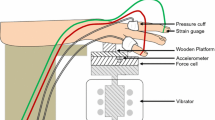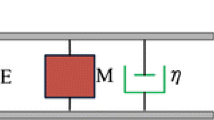Abstract
Objectives
This study investigated whether reductions in finger blood flow (FBF) during and after vibration are similarly dependent on the magnitude and duration of the vibration.
Methods
FBF on the left and right hand was measured every minute during, and for 1 h following, exposure of the right hand to one of three magnitudes of 125-Hz sinusoidal vibration (0, 22, or 88 ms−2 rms) for one of two durations (7.5 or 15 min). Each of five experimental sessions was comprised of five periods: (i) no force and no vibration (5 min), (ii) 2-N force and no vibration (5 min), (iii) 2-N force and vibration (7.5 or 15 min), (iv) 2-N force and no vibration (5 min), and (v) no force and no vibration (60 min).
Results
Vibration reduced FBF in the exposed and unexposed hands, both during and after vibration. With increased magnitude of vibration, there was increased vasoconstriction in all fingers during and after exposure, and longer recovery times after vibration exposure. With increased duration of vibration, there were no changes in vascular responses during exposure but increased vasoconstriction after exposure and prolonged recovery times. With the greater vibration magnitude, the reduction in FBF during exposure was correlated with the time taken to recover after exposure.
Conclusions
Subjects with greater reduction in blood flow during vibration exposure also have stronger and longer vasoconstriction during subsequent recovery. The correlation between vascular changes during and after vibration exposure suggests similar mechanisms control FBF during and after vibration exposure.



Similar content being viewed by others
References
Bovenzi M, Lindsell CJ, Griffin MJ (1998) Duration of acute exposure to vibration and finger circulation. Scand J Work Environ Health 24(2):130–137
Bovenzi M, Lindsell CJ, Griffin MJ (1999) Magnitude of acute exposure to vibration and finger circulation. Scand J Work Environ Health 25(3):278–284
Bovenzi M, Lindsell CJ, Griffin MJ (2000) Acute vascular responses to the frequency of vibration transmitted to the hand. Occup Environ Med 57(6):422–430
Bovenzi M, Welsh AJL, Griffin MJ (2004) Acute effects of continuous and intermittent vibration on finger circulation. Int Arch Occup Environ Health 77(4):255–263
Bovenzi M, Welsh AJL, Della Vedova A, Griffin MJ (2006) Acute effects of force and vibration on finger blood flow. Occup Environ Med 63:84–91
Curry BD, Bain JLW, Yan JG, Zhang LL, Yamaguchi M, Matloub HS et al (2002) Vibration injury damages arterial endothelial cells. Muscle Nerve 25:527–534
Egan CE, Hspie BH, McGrann S, McKenna KM, Allen JA (1996) Acute effects of vibration on peripheral blood flow in healthy subjects. Occup Environ Med 53:663–669
Greenfield ADM, Whitney RJ, Mowbray JF (1963) Methods for the investigation of peripheral blood flow. Br Med Bull 19:101–109
Griffin MJ (1990) Handbook of human vibration. Academic Press, London
Griffin MJ (1997) Measurement, evaluation, and assessment of occupational exposures to hand-transmitted vibration. Occup Environ Med 54:73–89
Griffin MJ, Bovenzi M (2002) The diagnosis of disorders caused by hand-transmitted vibration: Southampton Workshop 2000. Int Arch Occup Environ Health 75:1–5
Griffin MJ, Welsh AJL, Bovenzi M (2006) Acute response of finger circulation to force and vibration applied to the palm of the hand. Scand J Work Environ Health 32:383–391
International Organization for Standardization (2001) Mechanical vibration: guidelines for the measurement and the assessment of human response to hand-transmitted vibration. International Standard, ISO 5349-1
Luo J, Sakakibara H, Zhu SK, Kondo T, Toyoshima H (2000) Effect of vibration magnitude and repetitive vibration on finger blood flow in healthy subjects. Int Arch Occup Environ Health 73:281–284
Olsen N (1993) Vibration after effects on vasoconstrictors response to cold in the normal finger. Eur J Appl Physiol Occup Physio 66:246–248
Thompson AJL, Griffin MJ (2009) Effect of the magnitude and frequency of hand-transmitted vibration on finger blood flow during and after exposure to vibration. Int Arch Occup Environ Health 82:1151–1162
Ye Y, Griffin MJ (2011) Reductions in finger blood flow in men and women induced by 125-Hz vibration: association with vibration perception thresholds. J Appl Physiol 111:1606–1613
Ye Y, Mauro M, Bovenzi M, Griffin MJ (2012) Acute effects of mechanical shocks on finger blood flow: influence of shock repetition rate and shock magnitude. Int Arch Occup Environ Health 85:605–614
Conflict of interest
The authors declare that they have no conflict of interest.
Author information
Authors and Affiliations
Corresponding author
Rights and permissions
About this article
Cite this article
Ye, Y., Mauro, M., Bovenzi, M. et al. Association between vasoconstriction during and following exposure to hand-transmitted vibration. Int Arch Occup Environ Health 87, 41–49 (2014). https://doi.org/10.1007/s00420-012-0836-7
Received:
Accepted:
Published:
Issue Date:
DOI: https://doi.org/10.1007/s00420-012-0836-7




